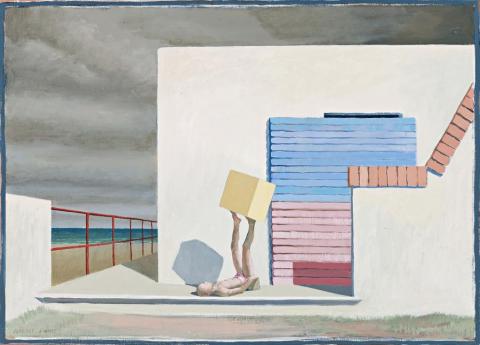STUDY FOR MORNING PRACTICE, BAIA, 1969
JEFFREY SMART
oil on canvas on composition board
36.0 x 50.0 cm
signed lower left: JEFFREY SMART
Macquarie Galleries, Sydney
Private collection, New South Wales
Jeffrey Smart, Macquarie Galleries, Sydney, 17–29 September 1969, cat. 18
Quartermaine, P., Jeffrey Smart, Gryphon Books Pty Ltd, Melbourne, 1983, pp. 64–65, 111, cats 540, 541
Smart, J., Capon, E., & Greer, G., Jeffrey Smart Drawings and Studies 1942–2001, Australian Galleries in association with Australian Art Publishing, Melbourne, 2001, p. 71
Drawing for Morning Practice, Baia (Circus Acrobats), 1965, ink on paper, 17 x 20.5 cm, illus. in Smart, J., Capon, E., and Greer, G., Jeffrey Smart Drawings and Studies 1942–2001, Australian Galleries in association with Australian Art Publishing, Melbourne, 2001, p. 71, cat. 70
Morning Practice, Baia, 1969/70, oil on canvas, 58 x 81 cm, illus. in Quartermaine, P., Jeffrey Smart, Gryphon Books Pty Ltd, Melbourne, 1983, pp. 65–66, cat. 154; also illus. in Smart, J., Capon, E., and Greer, G., op. cit., p. 71, fig. 9
We are grateful to Stephen Rogers, archivist for Jeffrey Smart, for his kind assistance
Jeffrey Smart considered Morning Practice, Baia 1969/70 'one of the best paintings I have done.'1 It is classic Smart, Study for Morning Practice, Baia offering a rare opportunity to enjoy the evolutionary sophistication of his masterly creativity. A fine work in its own right, it effectively illuminates the path of refinement that led to compositional perfection. In the realization of this achievement, it is surprising that Smart painted only one such study, although a related pen and ink drawing of 1965 does exist of two circus acrobats. The figure lying on his back balancing the yellow cube provided the motif in the two oil paintings. The clue to the success of the two oil paintings lies in balance, the image being a metaphor for Smart's art and its immaculate harmony of design and proportion. In both, brilliance of balance is heightened by witty interplay of geometric forms. Picture plane and recession are as poised as the yellow cube, objects and their tantalizing shadows perfect in placement. In addition to refinements in detail, texture and colour, there is a subtle change of viewpoint between the two. The study is slightly elevated, the larger painting lower and seemingly more close up - intimate. They share that enigmatic quality which is Smart's hallmark - the drama of utter stillness, the human figure in an environment familiar yet teetering on the alien. As the focus centres on the cube, the balancing act becomes more apparent, precariously on the edge, like the modern world, its insecurity and urban isolation. It is no accident that the other acrobat in the study drawing is a juggler keeping things in the air.
Smart chose the seaside resort Baia on the Bay of Naples for his setting. Famous in ancient Roman times as a highly fashionable resort for the fabulously rich and more popular than Capri, its reputation had a darker, hedonistic side. Seneca the Younger (4 BC - AD 65) described it as a 'vortex of luxury' and a 'harbour of vice'.2 Smart chose the seaside as the setting for some his best earlier paintings - Holiday Resort 1946, Elizabeth Bay 1961 and Castelfusano 1970, all in private collections, and San Cataldo I 1964, in the collection of the S.H. Ervin Gallery, Sydney. While Smart may claim that he puts 'figures in mainly for scale', they are there for other reasons too as this painting so readily demonstrates.3
1. Smart, J., Capon, E., and Greer, G., Jeffrey Smart Drawings and Studies 1942-2001, Australian Galleries in association with Australian Art Publishing, Melbourne, 2001, p. 71
2. Seneca the Younger, Epistles, vol. I, LII
3. Smart quoted in Capon, E., Pearce, B., and Quartermaine, P., Jeffrey Smart Retrospective, Art Gallery of New South Wales, Sydney, 1999, p. 92
DAVID THOMAS
